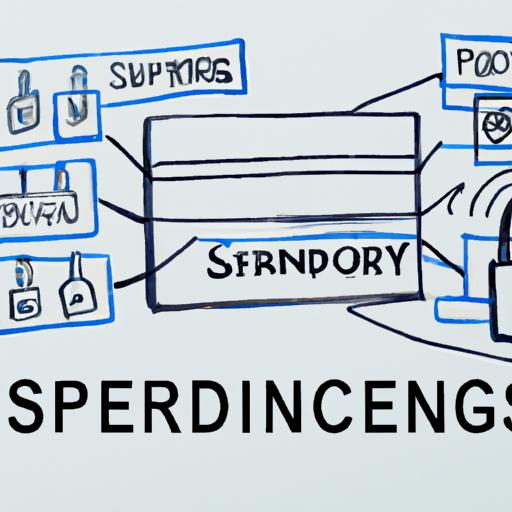The Ultimate Guide to Card Processing Security: Best Practices for Businesses
Are you ready to unlock the code to unbeatable card processing security? Look no further, wanderers of the electronic realm, because we present to you the ultimate guide that will make cyber criminals quiver in their digital boots! In this article, we will be your trusted companions on a thrilling journey into the world of card processing security, armed with the best practices that even the most wary businesses need to know. So, grab your cyber-sword and get ready to defend your precious cardholder data with finesse!
Understanding Card Processing Security: Protecting Your Business and Customers’ Data
Card processing security is of utmost importance when it comes to running a successful business. Not only does it safeguard your company’s data, but it also protects your customers’ sensitive information. Implementing best practices for card processing security is essential for building customer trust and mitigating the risk of data breaches.
One key aspect of card processing security is encryption. By using encryption technology, you can ensure that any data transferred between your business and the payment processor is securely encoded and can only be accessed by authorized users. Encryption acts as a protective shield against hackers and unauthorized individuals trying to intercept and misuse sensitive information.
Another important best practice is to regularly update your software and hardware. Outdated systems can leave your business vulnerable to security threats. Ensure that you are using the latest versions of payment processing software and update your hardware to comply with the latest security standards. Additionally, implementing software security patches as soon as they are released will further enhance your business’s protection against evolving cyber threats.
Furthermore, it is crucial to maintain strong passwords and user access controls. Use complex passwords that include a combination of upper and lowercase letters, numbers, and special characters. Avoid common phrases or easily guessable information. Consider implementing multi-factor authentication for added security. This way, even if someone manages to obtain a user’s password, they would still require an additional verification step to gain access.
To further protect your business and customers’ data, consider creating a company-wide security culture. Train your employees on best practices for handling card information, such as not writing down or sharing card details and reporting any suspicious activities. Regularly review your security protocols and conduct risk assessments to identify and address potential vulnerabilities. By prioritizing card processing security, you can safeguard your business and provide peace of mind to your valued customers.
The Importance of PCI DSS Compliance: Safeguarding Cardholder Information
In the ever-evolving world of online transactions, ensuring the security of cardholder information is of paramount importance for businesses. With the rise in cyber threats and data breaches, it has become crucial for organizations to adopt the Payment Card Industry Data Security Standard (PCI DSS) compliance. By adhering to these security guidelines, businesses can safeguard their customers’ sensitive data, maintain their reputation, and avoid costly penalties.
One of the key aspects of PCI DSS compliance is the protection of cardholder data. This includes not only the actual card numbers, but also the additional information such as cardholder name, expiration date, and CVV code. Implementing strong encryption and tokenization techniques can effectively mitigate the risk of unauthorized access and theft. Furthermore, regular vulnerability scans and penetration testing can identify any weaknesses in the network infrastructure, ensuring that potential vulnerabilities are promptly addressed and patched. By following these best practices, businesses can create a secure environment for card processing, instilling confidence in their customers and enhancing overall trust in their brand.
To illustrate the importance of PCI DSS compliance, here’s a simple table showcasing the potential impact of a data breach on businesses:
| Outcome | Cost |
|---|---|
| Fines and penalties | $100,000+ |
| Legal fees | $50,000+ |
| Forensic investigations | $25,000+ |
| Customer notification | $5 per affected person |
| Reputational damage | Priceless |
As you can see, the consequences of non-compliance can be both financially devastating and irreparably damaging to a business’s reputation. It is vital for businesses to proactively prioritize data security and stay up-to-date with the latest PCI DSS requirements to protect themselves and their customers from the ever-present threat of cyber attacks. Stay tuned for our upcoming articles where we’ll dive deeper into the world of card processing security, sharing more insight and practical tips to help your business thrive in the digital age.
Implementing Strong Authentication Measures: Enhancing Security and Trust
Nowadays, protecting customer data is more important than ever. As businesses continue to process credit card payments, it becomes crucial to implement strong authentication measures to enhance overall security and build trust with customers. By following these best practices, you can ensure your card processing systems are secure and minimize the risk of data breaches.
First and foremost, consider implementing multi-factor authentication (MFA) for all card processing accounts. MFA adds an extra layer of security by requiring users to provide multiple pieces of evidence to verify their identity. This can include something they know (such as a password), something they have (such as a physical security key), or something they are (via biometric authentication). By combining these factors, you significantly reduce the chances of unauthorized access to sensitive data.
Additionally, regularly updating and patching your software and systems is essential to staying protected against emerging threats. Outdated software can often contain vulnerabilities that hackers can exploit, making your business an easy target. Ensure your card processing applications, plugins, and operating systems are up to date to benefit from the latest security enhancements and bug fixes. Consider investing in a robust intrusion detection system (IDS) to monitor your network and detect any suspicious activity promptly.
To further fortify your card processing security, it’s crucial to limit access privileges to only those who genuinely need them. Grant access on a “need-to-know” basis, preventing unauthorized individuals from having unnecessary access to sensitive customer information. Regularly review and revoke access as employees change roles or leave the company to reduce the risk of insider threats.
As cyber threats continue to evolve, implementing strong authentication measures is not just an option – it’s a necessity. By taking these best practices into account, you can significantly enhance your card processing security, protect customer data, and establish a foundation of trust with your audience. Remember, prioritizing security today will pave the way for a thriving and reputable business in the future.
Conducting Regular Security Audits: Proactive Steps to Ensure Data Protection
Regular security audits are an essential part of maintaining robust data protection measures for businesses. By conducting these audits on a proactive basis, businesses can identify potential vulnerabilities and take immediate steps to address them, minimizing the risk of data breaches and unauthorized access.
When it comes to card processing security, businesses need to stay ahead of the curve. Regular security audits allow businesses to assess their existing security infrastructure and identify any gaps or weaknesses. This includes evaluating encryption protocols, firewall configurations, and access controls. With each audit, businesses can fine-tune their security systems and ensure that they are equipped to protect valuable customer data from unauthorized access or cyberattacks.
To make sure that your security audits are thorough and effective, consider creating a checklist that covers all aspects of your card processing infrastructure. This can include reviewing your payment gateway settings, checking for PCI compliance, and ensuring that your employees are following best practices for data protection. By regularly reviewing and updating this checklist, you can stay on top of emerging security threats and maintain the highest level of security for your business and customers. Don’t leave your data protection to chance – stay proactive and regularly conduct security audits to safeguard your sensitive information.
In Retrospect
And there you have it folks, the ultimate guide to card processing security! We’ve covered everything from the importance of securing your customers’ payment information to the best practices for businesses like yours. So put on your security cap, because it’s time to level up your card processing game!
Remember, in this digital age, where hackers lurk in every virtual corner, protecting your customers’ data is non-negotiable. But fear not, fellow business owners, for we’ve armed you with the knowledge and tools you need to ward off these cyber-evil-doers.
From using robust firewalls and encryption methods to keeping those pesky passwords under lock and key, you now know just what it takes to build a fortress around your payment ecosystem. And let’s not forget about that trusty PCI DSS compliance, ensuring you’re always one step ahead of potential security breaches.
But hey, it doesn’t stop there! Stay updated with the latest security technologies, educate your employees on phishing and social engineering, and, my friends, watch your business thrive in an era where trust and security go hand in hand.
So, as you embark on your quest to fortify your card processing security, remember to always be vigilant, embrace those best practices as your battle armor, and never underestimate the power of a secure payment environment.
Now, armed with this ultimate guide, you’re well-equipped to secure your customers’ trust, protect their sensitive data, and emerge as the hero of the card processing realm. Good luck, brave warriors of business! Stay safe, and may secure transactions be forever in your favor!






